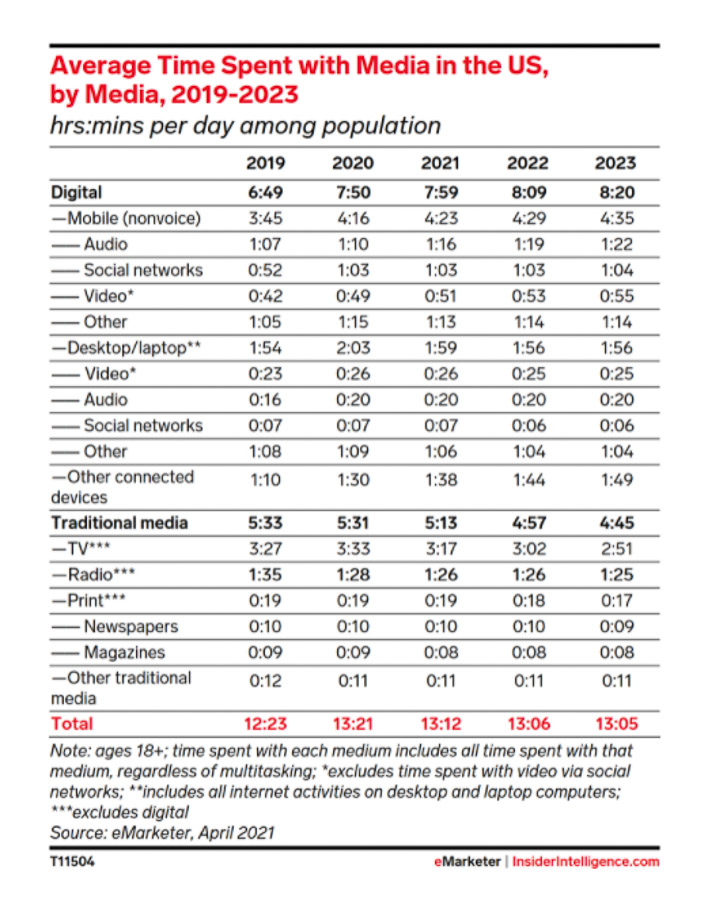
Whether you are a manufacturer designing tech gear for the residential market, or an integrator designing systems for your client’s homes, it can be helpful to better understand how they wish to use the gear or systems to consume media content. New statistical research shows that – no surprise – the average daily time U.S. consumers spent consuming media hit an all-time high in 2020…the year of COVID-19. You probably already knew this fact or at least suspected it to be the case. Now the data is in and between digital media and traditional media, the average consumption moved up by almost an extra hour a day.
But what you likely don’t know is – which specific media category saw increased use, which specific media category saw decreased use? And, most importantly, what happens now?
See the latest data forecasting of consumer media consumption…
The latest data from eMarketer on consumer media usage predicts some strong trends moving forward. The market researcher noted that “Last year, the average US adult spent more time per day with most media formats and devices, including TV.” Their first go forward projection is that they expect that this year will have nearly the same result.
In 2020, the average daily time consumers spent with media increased by nearly one hour (58 minutes) to a new record of 13 hours, 21 minutes (13:21). This was of course due to the fact that almost the entire country was in lockdown, and consumers were in their homes 24/7 to work-from-home while their kids learned-from-home, and the whole family engaged in various form’s of home entertainment.
A Rising COVID-19 Tide Raises All Media Boats
Ironically, according to eMarketer’s data, traditional media – including television and even print newspapers – saw their 2020 usage increase for the first time in years. Prior to COVID-19, both of these traditional media types had been in a multi-year decline.
For 2021, A Slight Decline Overall, But Increases Continue in Certain Categories
For 2021, the data shows a slight decline in the average daily media usage to 13:12. While that is down about 9 minutes, it is still well over the pre-pandemic daily average of 12:23 in 2019.
The study from the market researcher suggests that this slight decline in average daily usage of overall media will continue through 2023. Even so, these years will still show an overall increase in media consumption that exceeds the pre-pandemic level of 12:23 in 2019.
After 2020, Breaking Down the Details to See Where Things are Headed
What’s even more interesting is to take a closer look at the detail of which particular media type grows…and which media type declines. In this way, you get a better sense of where the US consumer’s focus will be down the road.
As a general rule, the traditional media sub-category will continue to decline, from a daily average of 5:33 in consumption in 2019 to 4:45 in 2023. Meanwhile, the digital media sub-category will continue to grow its share from a daily average consumption of 6:49 in 2019 to a robust 8:20 in 2023.
Another 9 Minute Rise, After a Previous 1+ Hour Rise
Just from 2020 to 2021, digital media will jump another 9 minutes. Keep in mind that this jump in average daily digital media usage is after it jumped more than an hour per day to 7:50 versus 6:49 the year before in 2020. And, as I noted above, while that growth will continue through 2023, the rate of growth will moderate somewhat.
For traditional media, however, the pace of decline will mostly increase. Compared to 2020, in 2021 consumers’ time spent with traditional media will drop 5.7%. Most of that decline hits the TV category, as consumers are watching less and less conventional TV. That 5.7% works out to 18 minutes less time per day consuming traditional media – of which 16 minutes of that overall decline comes specifically from less conventional TV viewing.
An Anomalous Year
The fact is, that while 2020 essentially turbocharged the already-started transition to digital media, for traditional TV – which picked up minutes per day on average – it was an anomalous year for the category, as it represented the category’s first pick up in average minutes since 2012. The researchers at eMarketer suggest this was due to people watching traditional TV news about “the pandemic, US elections, and social unrest.”
This year, the study projects that anomaly will reverse itself and traditional TV will be back in decline mode…coming in with total usage under the average hourly rate in 2020 and less than the rate experienced in 2019. The rate will continue to decline in the coming years, with traditional TV losing another 15 minutes per day in 2022 and another 11 minutes in 2023.
See more about eMarketer’s research by visiting: emarketer.com.







[…] digital TV and video content set to reach $119 billion by 2022 and content consumption in many categories continuing to grow this year , managing content effectively is business-critical for generating revenue and unlocking more […]